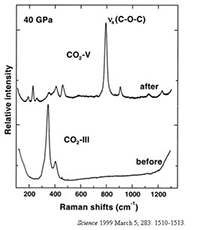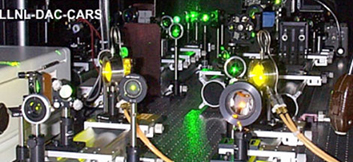Raman & FT-IR
Coherent Anti-Stokes Raman Spectroscopy
Raman & FT-IR
We study structural and bonding changes in molecular solids under applied pressure using optical (Raman and IR absorption) spectroscopy in the diamond anvil cell (DAC). The two techniques are complementary in the following ways:
Raman Spectroscopy
- Raman spectroscopy depends on a change in the induced dipole moment or polarization to produce Raman scattering.
- When a beam of photons strikes a molecule the photons are scattered elastically (Rayleigh scattering) and inelastically (Raman scattering) generating Stokes and anti-Stokes lines.
- Sensitive to homo-nuclear molecular bonds: for example, it can distinguish between C-C, C=C and C≡C bonds.
- Useful for studying the external vibrations in condensed molecular systems.
- Requires little sample prep.
- Presence of fluorescence can prohibit a spectrum being taken, not a major problem with FT-Raman.
- Fair sensitivity.
- Good microscopic technique.
Optical spectroscopy measurements in the DAC reveal bonding changes in CO2 from a molecular O=C=O to a single-bonded tetrahedrally coordinated extended solid (similar to SiO2):
FT-IR Spectroscopy
- Fourier transform infrared (FT-IR) spectroscopy measures dominant vibrations of functional groups and highly polar bonds. FT-IR spectrometers record the interaction of IR radiation with the sample, measuring the frequencies at which the sample absorbs the radiation and the intensities of the absorptions.
- Sensitive to hetero-nuclear functional group vibrations especially OH stretch in water.
- Method imposes constraints on sample thickness, uniformity and dilution to avoid saturation.
- Requires N2 purging or vacuum to avoid strong absorption by atmospheric water vapor.
- Good sensitivity.
- More difficult to use microscopic techniques for DAC measurements.
Coherent Anti-Stokes Raman Spectroscopy
Samples above 2000K emit a large amount of Planck radiation. The broad thermal background generated from high temperatures easily overwhelms any signal generated by classical Raman spectroscopy. However, CARS (Coherent Anti-Stokes Raman Spectroscopy) provides us with a means of generating a Raman signal that is largely spatially and temporally isolated from this incandescent background. Thus, we have constructed a laser system capable of providing the two colors necessary for broadband CARS for any Raman active vibration of interest. This has been accomplished by the construction of two cavity dumped dye lasers which are synchronously pumped by a mode locked Q-switched Nd:YAG laser. One of the dye lasers is set up to be broadband, while the other is narrow band and tunable. The two pulses (one broadband plus one narrow band from either the other dye laser or the frequency doubled Nd:YAG) must overlap in the sample spatially and temporally to be effective. The typical time scale of the pulses used in our CARS experiment is ~100 ps for the frequency doubled Nd:YAG pulses and 30 ps for the dye pulses. This means that we have subnanosecond time resolution that can be used with a Q-switched Nd:YAG pulse (typical duration of 100 ns) for heating. However, it must be noted that for CARS to work, a sample must be transparent and have a significant third order polarizability. Fortunately, diamond, hydrogen, methane, and nitrogen have these properties.
Direct cw laser heating with either a Nd:YAG or CO2 laser is ineffective for most samples. There are no electronic or vibronic absorption bands for most of the molecules listed above in the region that those two lasers operate. Some molecules, such as N2 and H2, have no dipole moment and absorb only in the vacuum UV (which is opaque to diamond). Although they cannot be heated directly, we can fabricate a target for laser heating a sample indirectly. By using EDM (Electric Discharge Machining) we have made toroids composed of tantalum or tungsten metal. These toroids typically have an outer diameter of 90 microns and an inner diameter of 40 microns while being only 15 microns thick. These dimensions are slightly smaller than that of a typical sample at 20 GPa. The toroid must be placed so as not to touch either diamond culet. By focusing the laser on the toroid, the part of the sample inside the toroid aperture will be heated to the same temperature as the inner toroid wall. The result is a finite sample volume of a measurable uniform temperature. This setup allows for the laser beams of a CARS experiment to cross inside the aperture. The toroids can withstand temperatures well in excess of 3000K at high pressure.






